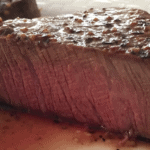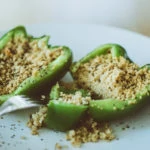Basil is well-researched across the Internet, and I found a wealth of cooking tips using this herb with a brief search. Here’s my gleaning of the most interesting things you should know about the magnificent world of basil. It’s a big family!
What is Basil?
Basil is a mint family, leafy green herb. The most common cultivar is called sweet basil, and is native to the tropics of Central Africa and Southeast Asia. Sweet basil an aromatic herb often found in Italian tomato sauce and other sweet and savory foods from cuisines including Indonesian, Vietnamese, and Thai. Sweet basil has many health benefits too.
What Does Basil Look Like?
The mint family is broad, and number of basil varieties within it is nearly as large.
Basil is an annual and sometimes a perennial. The sweet basil plant looks bright green, and is sometimes purple-tinged. Its leaves are oval-shaped, slightly cupped, and glossy. Sweet basil leaves grow in pairs opposite one another on square stems. The sweet basil plant blossoms white or magenta.
How Many Varieties Of Basil Are There?
There are many varieties of cultivated basil. Some are used in the kitchen, some just as landscape plants, others as healing herbs and teas, and still others as worship implements.
Most types of basil used in the kitchen have a distinct flavor that comes from the cultivars of Ocimum basilicum, also known as sweet basil.
The Ocimum genus includes other basil species, known in the kitchen and garden as holy basil, lemon basil, Thai basil, cinnamon basil, and African blue basil.
Proper sweet basil (O. basilicum) smells like clove when it is fresh.
Thai basil smells like licorice. It is sometimes called ‘anise basil’ or ‘licorice basil.’ It’s small leaves hold up better than sweet basil when cooking at high temperatures.
Lemon basil has a strong lemon smell and tastes exceptionally sweet. It is also known as ‘Indonesian basil,’ and compliments Asian foods like stews, curries, rice dishes, and stir-fries.
Holy basil is also known as ‘sacred basil’ for its use in Ayurveda. Holy basil has a strong, spicy clove smell, and is popular in Thai cooking.
African blue basil is a purple, perennial basil that has a strong camphor smell.
Cinnamon basil is also known as ‘Mexican basil.’ Its leaves have the same chemical in them that cinnamon does, which gives cinnamon basil its name and cinnamon flavor.
What Does Basil Taste Like?
Basil, especially sweet basil, is the strong smell that fragrances many vegetable and herb gardens. It smells sweet, peppery, and a little minty. Depending on the cultivar, sweet basil’s taste ranges in sweetness and clove- or pepperiness.
How To Cook with Basil
Basil adds fresh flavor to food and also supports good digestion. Eating basil is my favorite activity when wandering in a garden.
In cooking, you can use basil oil, dried basil, and fresh basil.
Chopping vs Macerating
The best way to embrace sweet basil’s fresh herb flavor is to damage the leaves naturally by tearing or pounding them. Chopped basil does not give off as strong of essential oils as do the macerated or muddled basil leaves. Add the macerated fresh herb to just-cooked or cold foods. One of my favorite fresh uses is to garnish Thai noodles or stir-fries with holy basil leaves.
Simple Pesto Recipe
One dish that requires lots of fresh basil, sometimes Thai basil, is pesto. If you’re making your own pesto, around one dozen sweet basil plants will give you full bowl of incredible sweet basil pesto. My favorite variety for basil pesto is lemon basil, for its tart flavor. I think it matches well with fatty pine nuts and olive oil.
To make pesto and other sweet basil-infused dressings, pound the fresh basil leaves in a mortar and mix with olive oil, balsamic vinegar, lemon juice, and/or pine nuts. Store basil pesto for later use in an ice cube tray in the freezer.
Using Dried Basil
Dried basil can be crumbled or sprinkled into foods while they cook. One of our favorite recipes using dried basil is this recipe for Pan-Seared Halibut, and of course spaghetti. Hit the mark by learning How to Make Perfect Spaghetti Every Time with basil tomato sauce.
Since dried basil’s plant essential oils are less pungent that the essential oils in fresh basil, add dried basil to foods while they cook. Heating dried basil releases its pungent flavor and smell.
You can dry your own basil by hanging several fresh basil leaves still on the stem in a dry place. When they are crispy, crunch them into a jar or other airtight container. Another method is to freeze and dry basil by placing several leaves in an airtight container in the freezer. Use these by crunching, frozen, into food before cooking.
Basil Oil & Extracts
Basil oil is a basil-infused vegetable oil like olive oil. You can make basil oil by blanching basil leaves in water then blending the leaves with olive oil. Basil oil is delicious drizzled over toast and pasta.
Basil essential oil is a magnification of the sweet basil compounds found in this aromatic plant. Use just a few drops to flavor sauces, pasta, and soups.
There are many medicinal plant oils found in sweet basil. When concentrated into basil essential oil, these plant oils offer great health benefits. You can add holy basil essential oil to hot water to make basil tea. Or, make basil tea by steeping a few fresh holy basil leaves in water.
Basil extracts are also used medicinally for the herb’s antimicrobial and antioxidant activities. Specifically, holy basil is one of several Indian medicinal plants that has been used to lower blood pressure, reduce blood clotting, and to relieve anxiety and stress.
Buying basil
Sweet basil is sold in many forms, including as an essential oil, dried basil, mixed with olive oil in jars as a blended basil paste similar to pesto, as a potted plant, and fresh-cut.
When purchasing commercial essential oils, look out for organic forms of basil extract as they tend to house the most pure basil oils and give the best health benefits.
When purchasing cut, fresh basil, look for stems that stand up straight and that don’t have curled or wimpy leaves.
How to Store Basil
Basil is best used fresh-cut from your own aromatic plants. If you don’t have your own basil plants, you can freeze fresh basil from the store in an airtight container for a several months, store it in the fridge for up to one week, or bottle dried basil in a glass jar in a dry cupboard for up to six months.












